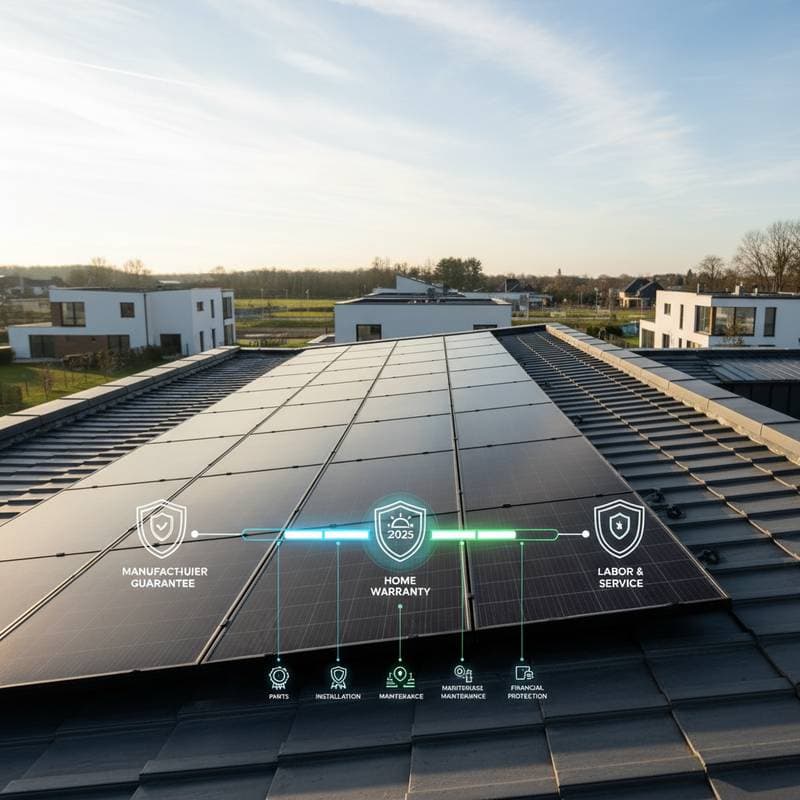Safeguard Solar Systems with 2025 Home Warranties
Homeowners who invest in solar energy seek predictable costs and reliable protection against equipment failures. A solar system represents a long-term asset that relies on components such as inverters, wiring, and panels, all of which face risks from heat exposure, corrosion, or electrical issues. A comprehensive home warranty plan that incorporates solar coverage shields owners from the full expense of replacements or labor when problems arise.
This guide details the mechanics of solar warranties within home warranty plans, outlines coverage inclusions and exclusions, and provides strategies for selecting appropriate protection levels tailored to specific systems.
Benefits, Drawbacks, and Ideal Applications
Benefits
- Establish predictable annual expenses for service calls
- Provide a single contact point for various trades involved in repairs
- Extend labor coverage beyond the duration of manufacturer warranties
- Preserve the overall value of the solar system during home sales
Drawbacks
- Impose limits on coverage amounts per incident or annually
- Feature service networks that may lack specialized solar expertise
- Exclude pre-existing conditions or issues stemming from improper installation
Ideal Applications
- Residences equipped with grid-tied solar systems exceeding 3 kilowatts
- Properties located in hot or coastal regions prone to heightened corrosion risks
- Owners intending to retain ownership of the home for a minimum of five years
Step-by-Step Process for Obtaining Coverage
- Compile essential system information. Document the wattage of panels, the model of the inverter, and the date of installation to facilitate accurate quoting.
- Solicit quotes from a minimum of three warranty providers. Inquire specifically about their use of licensed solar technicians to ensure quality service.
- Evaluate contract details thoroughly. Pay close attention to coverage caps, service fees, exclusion clauses, and provisions related to roof leaks.
- Arrange for an inspection if mandated. Certain providers require verification of proper installation prior to coverage activation.
- Maintain records of ongoing maintenance. Log activities such as inverter firmware updates and panel cleaning schedules to support claim validity.
This entire process typically spans one to two weeks, from initial research through to policy activation. Contracts generally renew on an annual basis, allowing for periodic reviews and adjustments.
Common Pitfalls to Sidestep
- Overrelying on manufacturer warranties for labor expenses. The majority of panel warranties address parts replacement exclusively, leaving labor costs to the owner.
- Overlooking potential conflicts with roof warranties. Certain roofing guarantees become invalid if solar mounts penetrate surfaces without approved flashing methods.
- Permitting maintenance oversights to invalidate coverage. Accumulation of dirt or persistent shading may qualify as neglect under policy terms.
- Opting for the lowest-priced plan available. Budget options frequently restrict payouts to levels below prevailing regional labor rates, leading to out-of-pocket expenses.
Select a plan with per-item limits that correspond to local labor costs. Scrutinize these elements prior to finalizing payment to avoid surprises.
Guidelines for Professional versus Self-Maintenance Decisions
Employ the DIY Gate framework to determine whether to manage solar servicing independently or engage warranty-approved technicians.
| Factor | Pursue DIY if... | Engage a professional if... |
|---|---|---|
| Skill alignment | You possess the ability to safely isolate DC circuits and interpret inverter error codes | You lack confidence in isolation protocols |
| Safety concerns | The roof pitch measures under 6:12 and the array remains accessible without excessive risk | The roof presents a steep incline or panels border precarious edges |
| Tool resources | You maintain ownership of a multimeter and appropriate safety harness | You do not have access to fall protection or tools rated for DC voltage |
Individuals inclined toward DIY approaches can focus on tasks like panel cleaning and output monitoring. However, any work involving electrical component replacement or roof modifications requires the involvement of a licensed solar electrician to uphold warranty compliance.
Essential Preparation Checklist for Solar Maintenance
Required Tools
- Ladder suitable for the roof's height and load capacity
- Torque wrench equipped with metric sockets for secure fastening
- Multimeter and clamp meter for electrical diagnostics
Necessary Skills
- Fundamental knowledge of electrical safety procedures
- Proficiency in interpreting data from inverter display screens
Safety Equipment
- Hard hat for head protection
- Insulated gloves for electrical handling
- Full-body harness with anchorage points
Permit Requirements
- No permits needed for routine cleaning or visual inspections
- Electrical permits mandatory for inverter or wiring replacements
Preliminary Tasks
- Deactivate all solar disconnect switches
- Allow five minutes for capacitor discharge to eliminate residual voltage
Environmental and Site Considerations
- Refrain from operations during rainfall or winds exceeding 20 miles per hour
- Confirm the roof surface remains completely dry before ascending
Evaluating Service Providers and Warranty Options
To assess warranty plans that bundle service provisions, construct a comparison table incorporating key metrics.
| Category | Detail or Requirement | Provider A | Provider B | Provider C | Key Variations |
|---|---|---|---|---|---|
| Solar Expertise | Years of experience | 8 | 3 | 10 | Target providers with at least five years |
| Service Charge | Cost per visit | $100 | $75 | $125 | Verify inclusion of diagnostic services |
| Response Timeline | Hours to appointment | 48 | 72 | 24 | Shorter times minimize system downtime |
| Coverage Cap | Limit per claim | $2,000 | $1,500 | $2,500 | Align with actual inverter replacement costs |
Robust plans specify precise response timelines and payout thresholds that reflect regional labor realities. Cross-reference these against your system's specifications for optimal fit.
Implementing Effective Solar Protection
Initiate the process by reviewing existing solar documentation, including manufacturer warranties, installer guarantees, and roof-related terms. Subsequently, obtain quotes for home warranties featuring solar inclusions. Ensure coverage limits accommodate the expenses associated with inverter replacement and labor for panel removal during roof repairs.
Store digital versions of all contracts and inspection reports for streamlined claims processing. These documents not only facilitate repairs but also enhance buyer confidence and potentially elevate property value upon sale.
Integrating solar components into a home warranty serves as prudent insurance against unforeseen repair demands. Through thoughtful plan selection, owners sustain consistent energy savings, ensure roof integrity, and maintain operational safety across the system's lifespan.



